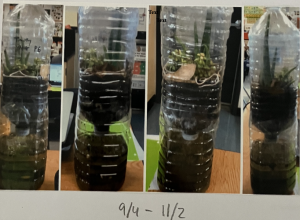Rainforest by Ellie S. (6th G)
Geographic Information
1A. Tropical rainforests are mainly located between the latitudes of 23.5°N (the Tropic of Cancer) and 23.5°S (the Tropic of Capricorn)—the tropics. Tropical rainforests are found in Central and South America, western and central Africa, western India, Southeast Asia, the island of New Guinea, and Australia.
1B. Abiotic factors of the rainforest include soil, water, rocks, light, and climate. The soil is usually poor in a tropical rainforest because the heavy rainfall washes away nutrients and it is usually acidic. The abiotic factors of this rain forest biome are: the amount of water and sunlight, its climate and weather, and the levels of precipitation. These factors affect the trees and animals that live there.
1C. Very wet with over 2,000 mm of rainfall per year.Very warm with an average daily temperature of 28°C. The temperature never drops below 20°C and rarely exceeds 35°C. The atmosphere is hot and humid.The climate is consistent all year round. There are no seasons.
1D. In the tropical rainforest, however, rainfall is year round, and can be daily. This strips out most of the nutrients. Many of these soils are Oxisols and Ultisols. In an oxisol, even the clays have been leached out of the soil, and replaced with aluminum oxides.
Animal and plant life
2A. Some plants are:
Rubber Tree
From the economical point of view, a rubber tree is the most important plant of the rainforest. These trees are mostly 100 feet tall. The rubber sap produced by the trees is used for the manufacturing of latex that is still used in the present era for the production of goods made with rubber and special tires of cars. The inner bark of the trees will produce latex when it is damaged or cut. It is a very unique sight to see. There was a time when the plant was only found in the Amazon rainforests but the seeds of the plants were smuggled in other parts of the world, and, providing the required conditions, experts will be able to grow the trees in different parts of the world.
Cacao
There is no person in the world who does not love chocolate. There is at least one type of chocolate that is loved by everyone in the world. Chocolate might be the favorite food in the world but the cocoa plant is the superfood found among the tropical forest plants that are loaded with several health benefits. You can get natural energy with the consumption of raw cacao in your diet. It also has several mental benefits. The plant will help improve your focus. It is loaded with iron and calcium that allows you to stay healthy. It is perfect for the heart and brain, because of the highest content of calcium in the plants.
Goliath Water Lilies
On the off chance that you have ever experienced an Amazon River journey or remained in a wilderness stop, you may see these noteworthy Victoria water lilies amid one of your wilderness trips. These water lilies are not your normal blossom – they grow up to 3 meters in distance across – envision, you could set down on one! They were named after Queen Victoria of the UK.
Food Web
Energy pyramid
2B. Some animals are:
MOUNTAIN GORILLA – Mountain gorillas are the largest living primates on earth! Along with chimpanzees, orangutans, and bonobos, they are the closest living relatives of humans, with mountain gorillas having the most developed brains of the four. They live primarily on the lush mountain sides of national parks in Rwanda, Uganda, and the Democratic Republic of Congo in Central Africa. Mountain gorillas live in groups of roughly 30 members, with one dominant, male troop leader called a ‘silverback’ for the silver color in his coat.
BLUE MORPHO BUTTERFLY – With its brilliant, iridescent blue wings, the blue morpho butterfly flutters through the rainforest canopy. The many “eyespots” on its brown underside trick predators into thinking the butterfly is a large predator.
OKAPI – The striking okapi—the closest living relative of the giraffe—lives in the dense tropical Ituri Forest of Central Africa. A master of camouflage, its striped hindquarters and brown hide helps it “disappear” into the filtered light of the forest.
BROWN-THROATED THREE-TOED SLOTH – The slow-moving sloth, weighing only eight or nine pounds, lives exclusively in trees, feeding on leaves, twigs, and fruit. It moves so slowly that its fur takes on a green tinge from the algae that grows on it. It can take a month to digest a single meal.
POISON DART FROG – One of the most brightly colored animals on the planet, the poison dart frog uses its color to warn predators of the toxic venom that lies within its skin. Indigenous cultures often use this frog’s poison to coat the tip of blow darts used for hunting.
Rain falls
3A. An average of 50 to 260 inches (125 to 660 cm.) of rain falls yearly. Rain forests belong to the tropical wet climate group. The temperature in a rain forest rarely gets higher than 93 °F (34 °C) or drops below 68 °F (20 °C); average humidity is between 77 and 88%; rainfall is often more than 100 inches a year.
3B. The average temperature in tropical rainforests ranges from 70 to 85°F (21 to 30°C). The environment is pretty wet in tropical rainforests, maintaining a high humidity of 77% to 88% year-round. The yearly rainfall ranges from 80 to 400 inches (200 to 1000 cm), and it can rain hard.
3C. Changing climate leads to forest degradation.
As temperatures increase, so do forest fires. Tropical rainforests typically get over 100 inches of rain a year, but each year this number decreases — creating a chain effect of consequences.
Today tropical rainforests
4A. Today tropical rainforests are disappearing from the face of the globe. Much of this remaining area has been impacted by human activities and no longer retains its full original biodiversity.
Deforestation of tropical rainforests has a global impact through species extinction, the loss of important ecosystem services and renewable resources, and the reduction of carbon sinks. However, this destruction can be slowed, stopped, and in some cases even reversed.So, what should be done? The solution must be based on what is feasible, not overly idealistic, and depends on developing a conservation approach built on the principle of sustainable use and development of rainforests. Beyond the responsible development of rainforests, efforts to rehabilitate and restore degraded forest lands along with the establishment of protected areas are key to securing rainforests for the long-term benefits they can provide mankind.
https://rainforests.mongabay.com/10-how-to-save-rainforests.html
4B. Other animals
Jaguar.
Golden lion tamarin.
The South American Tapir.
Giant Otters.
The Uakari Monkey.
White-Cheeked Spider Monkey.
Hyacinth Macaw
Threats
- Logging interests cut down rainforest trees for timber used in flooring, furniture, and other items.
- Power plants and other industries cut and burn trees to generate electricity.
- The paper industry turns huge tracts of rain forest trees into pulp.
- The cattle industry uses slash-and-burn techniques to clear ranch land.
4C. As well as the vivid beauty that comes with great diversity in plants and animals, rainforests also play a practical role in keeping our planet healthy. By absorbing carbon dioxide and releasing the oxygen that we depend on for our survival. The absorption of this CO2 also helps to stabilize the Earth’s climate.They make much of the oxygen humans and animals depend on. Without them, there would be less air to breathe! Rainforests also help maintain Earth’s climate. By taking in carbon dioxide, they help to reduce the greenhouse effect.
4D. As the human population grows the need for agriculture, energy and development space increases with it. Tropical rainforests cover a massive amount of the world’s tree surface, each year over 90,000 square miles of the forests are harvested for human use. This deforestation has worried environmentalists because of the release of carbon from the machinery and the vegetation. It is believed that deforestation may accelerate the effects of global warming and transform the rainforest climate. Tropical Rainforests harbor 50% of world’s biodiversity, the massive deforestation of the forest has caused the total land mass to go 15 million km squared to about 8 million km squared, this is nearly half; it is estimated that nearly 2% of the rainforest is lost annually. Furthermore, Approximately 137 species are lost in this biome per day, including both species of plants and animals and insects.
4E. 2% of the Amazon Rainforest is getting destroyed per year. I don’t think there will be a rainforest in the future.
Bibliography:
https://www.rainforest-alliance.org/articles/11-amazing-rainforest-animals
https://www.nationalgeographic.com/environment/habitats/rain-forests
References:
Lots of research using the internet, pictures are all from internet.






